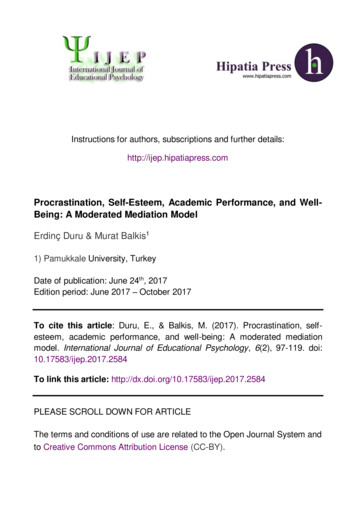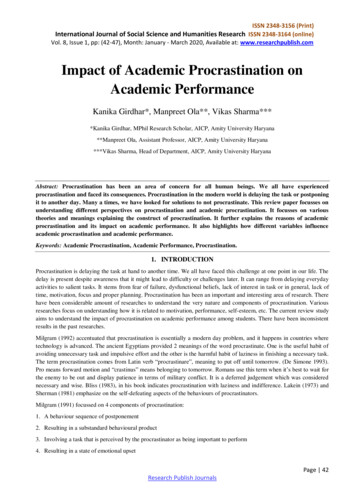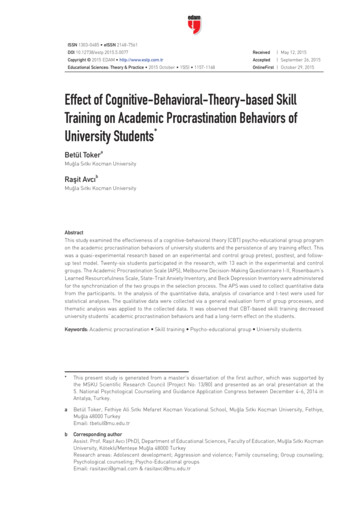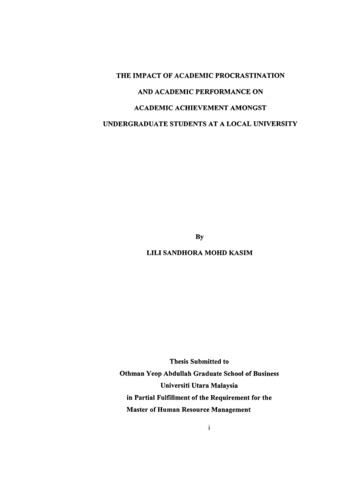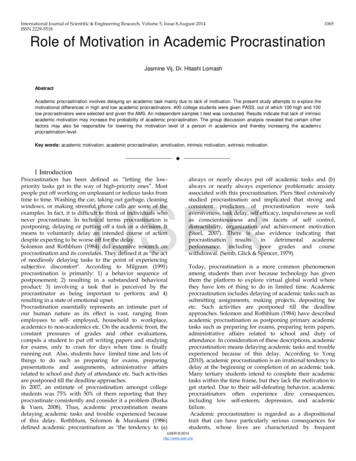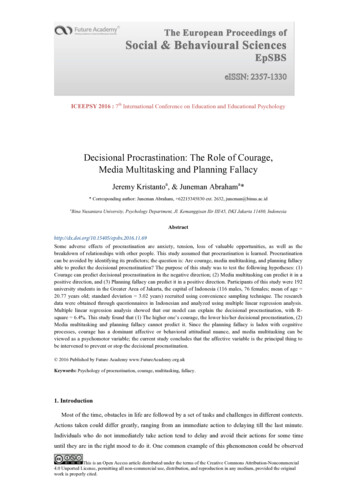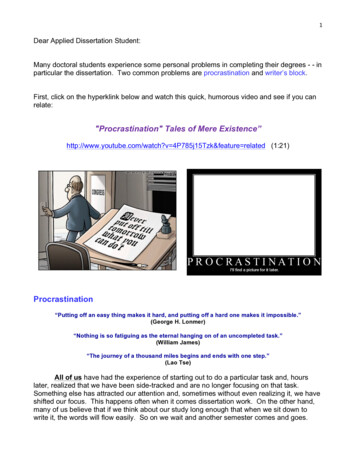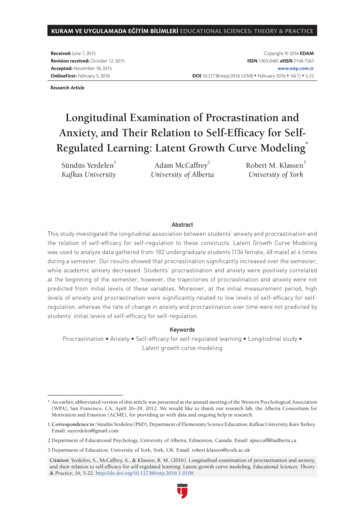
Transcription
KURAM VE UYGULAMADA EĞİTİM BİLİMLERİ EDUCATIONAL SCIENCES: THEORY & PRACTICEReceived: June 7, 2015Revision received: October 12, 2015Accepted: November 18, 2015OnlineFirst: February 5, 2016Copyright 2016 EDAMISSN 1303-0485 eISSN 2148-7561www.estp.com.trDOI 10.12738/estp.2016.1.0108 February 2016 16(1) 5-22Research ArticleLongitudinal Examination of Procrastination andAnxiety, and Their Relation to Self-Efficacy for SelfRegulated Learning: Latent Growth Curve Modeling*1Sündüs YerdelenKafkas University2Adam McCaffreyUniversity of Alberta3Robert M. KlassenUniversity of YorkAbstractThis study investigated the longitudinal association between students’ anxiety and procrastination andthe relation of self-efficacy for self-regulation to these constructs. Latent Growth Curve Modelingwas used to analyze data gathered from 182 undergraduate students (134 female, 48 male) at 4 timesduring a semester. Our results showed that procrastination significantly increased over the semester,while academic anxiety decreased. Students’ procrastination and anxiety were positively correlatedat the beginning of the semester; however, the trajectories of procrastination and anxiety were notpredicted from initial levels of these variables. Moreover, at the initial measurement period, highlevels of anxiety and procrastination were significantly related to low levels of self-efficacy for selfregulation, whereas the rate of change in anxiety and procrastination over time were not predicted bystudents’ initial levels of self-efficacy for self-regulation.KeywordsProcrastination Anxiety Self-efficacy for self-regulated learning Longitudinal study Latent growth curve modeling* An earlier, abbreviated version of this article was presented at the annual meeting of the Western Psychological Association(WPA), San Francisco, CA, April 26–29, 2012. We would like to thank our research lab, the Alberta Consortium forMotivation and Emotion (ACME), for providing us with data and ongoing help in research.1 Correspondence to: Sündüs Yerdelen (PhD), Department of Elementary Science Education, Kafkas University, Kars Turkey.Email: suyerdelen@gmail.com2 Department of Educational Psychology, University of Alberta, Edmonton, Canada. Email: ajmccaff@ualberta.ca3 Department of Education, University of York, York, UK. Email: robert.klassen@york.ac.ukCitation: Yerdelen, S., McCaffrey, A., & Klassen, R. M. (2016). Longitudinal examination of procrastination and anxiety,and their relation to self-efficacy for self-regulated learning: Latent growth curve modeling. Educational Sciences: Theory& Practice, 16, 5-22. http://dx.doi.org/10.12738/estp.2016.1.0108
EDUCATIONAL SCIENCES: THEORY & PRACTICELife in school and university is burdened with deadlines and seemingly endlessamounts of work. Students must cope with stressful timeframes and manage theiracademic anxiety (Misra & McKean, 2000). Ironically, one of the greatest challengesin the academic realm is not the quantity of assignments but the tendency of studentsto delay the process of working towards their goals. By this logic, it is not necessarilythe difficulty of the work that students struggle with but instead their ability to selfregulate, stay on track, and complete their work. Procrastination has been definedas a failure to self-regulate to achieve intended goals, which results in a time delay(Steel, 2007). Procrastination has been seen as a universal phenomenon that hinderspeople’s ability for accomplishing their goals (Steel, 2007). Academic procrastinationspecifically looks at the delay and postponing of academic tasks (Sirin, 2011).According to Yong (2010), academic procrastination is “an irrational tendency todelay at the beginning or completion of an academic task” (p. 63). Indeed, manystudents do not have sufficient drive to start their academic work, even when theyintend to complete it by the deadline. Academic procrastination has been seen torelate to students missing deadlines, delaying studying, lower grades, and evenwithdrawing from courses (Beswick, Rothblum, & Mann, 1988). The prevalencerates for academic procrastination at the university level are high, and counteringprocrastination is considered to be one of the most important factors to student success(Steel, 2007). It is estimated that 80% to 95% of students at the university or collegelevel suffer from academic procrastination (Ellis & Knuas, 1977). Others estimate30% to 50% of students reporting that they have troubles with primary tasks such aswriting a term paper, preparing for exams, and doing weekly readings (Clark & Hill,1994; Solomon & Rothblum, 1984). In a large-scale sample, Steel and Ferrari (2013)found that procrastination was associated with lower education levels, showing theimportance of self-regulation skills in achieving higher education goals. Solomon andRothblum (1984) stated that the primary reasons that college students procrastinate isrelated to task aversiveness, fear of failure, evaluation anxiety, low self-confidence,perfectionistic standards for success, and difficulty in decision making.The Link between Anxiety and ProcrastinationAnxiety is defined as “an emotion based on the appraisal of threat, an appraisalwhich entails symbolic, anticipatory, and uncertain elements” (Lazarus & Averill,1972, p. 487). Anxiety is closely related to a fear of future harm or potential futurethreats (Reiss, 1991). Prior studies have shown that anxiety can have a debilitatingeffect on academic performance (Macher, Paechter, Papousek, & Ruggeri, 2012).In an earlier study of anxiety relating to procrastination, Lay (1989) found that stateanxiety was associated with perceptions of threat, harm, and emotion-focused coping.It has been found that in graduate students academic procrastination is significantlyand positively related to anxiety, with a majority of it related to tasks such as writing,6
Yerdelen, McCaffrey, Klassen / Longitudinal Examination of Procrastination and Anxiety, and Their Relation to Self-Efficacy.studying, and weekly readings (Onwuegbuzie, 2004; Onwuegbuzie & Jiao, 2000).Rothblum, Solomon, and Murakami (1986) stated that academic procrastinationusually included a problematic level of anxiety. Although most studies found positivecorrelations between academic procrastination and academic anxiety, these studiesdo not emphasize a causal relationship (Onwuegbuzie, 2000). That is, the crosssectional correlational analyses from these studies reveal that there is a positive andsignificant relationship between procrastination and the interpretation of anxiety,including test and class anxiety. Therefore, anxiety and procrastination have—forthe most part—been measured at single time points, revealing only these relationswithin a narrow temporal time point. However, interestingly, studies have linkedprocrastination with a decline in physical and mental health, with some studiesarguing that stress and illness are higher for procrastinators but only at the end of asemester (Tice & Baumeister, 1997). Furthermore, procrastinators may suffer fromless stress than others in the early parts of the school year due to spending less timeon tasks; however, they experience much greater stress afterward. The complexrelationship between procrastination and anxiety must consider both the bidirectionalrelationship between factors, and the influence of time.In Steel’s (2007) meta-analysis on procrastination, anxiety appears in a numberof different capacities. In one respect, anxiety is seen as similar to neuroticism;those who are anxious procrastinate because they feel stressed and this creates taskaversion (Burka & Yuen, 1983; Ellis & Knaus, 1977). It is even suggested that highlyanxious people catastrophize small situations and that this causes their need foremotional coping. In another domain, anxiety is suggested to be a result of irrationalbeliefs or maladaptive thought patterns similar to those associated with neuroticism(Aitken, 1982; Ellis, 1973). Anxiety of a neurotic origin is also thought to relate toa fear of failure, self-consciousness, and perfectionism (Steel, 2007). Steel points toanother line of research and suggests that the anxiety–procrastination relation mayemerge from the individual’s attempt to improve their temporal mood, thus, relatingto emotion-focused coping. For example, those who feel upset or anxious about theircurrent workload can engage in a short-term mood repair (doing something else),thus helping themselves feel better in the present (Sirois & Pychyl, 2013).Steel (2007) suggests that procrastination exists in a more complicated formulation,whereas previous research primarily looks at simple relations. Specifically, Steel’(2007) developed the Temporal Motivation Theory which suggests that time is acritical factor in goal motivation. This model attempts to understand the impact oftime and whether approaching deadlines increases or decreases motivation to achievea goal. Steel’s model refers to how an individual is motivated based on their cognitiveestimate of the utility of a task or choice. Utility refers to “how desirable a taskor choice is for an individual” (Steel, 2007, p. 71). In this equation, utility can be7
EDUCATIONAL SCIENCES: THEORY & PRACTICEdetermined by the expectancy and value of the task in the numerator with the elementof time in the denominator (see Steel, 2007). Expressed in these terms, people tendto like tasks that provide a high value and take little time to achieve, while theyalso prefer to delay aversive tasks. Steel suggests that anxiety causes an individualto delay tasks to a later time, however, as the deadline approaches, the utility ofprocrastination increases to the point of delaying up until the “last minute.” However,there are very few repeated measures studies looking at how this relation exists interms of anxiety and procrastination. Rothblum et al. (1986) found that those havinga high level of procrastination tended to be more anxious during the whole schoolsemester; however, they also tended to have lower stress levels in the early parts ofthe semester. Other studies have found similar results in which the procrastinationand anxiety relation increased towards the end of the semester (Assur, 2003; Lay& Schouwenburg, 1993). These studies suggest that there is a relationship betweenanxiety and procrastination across a semester. However, the extent and direction ofthis relation across a semester remains unexamined. Additionally, this relation may becomplicated by the fact that anxiety is based on an appraisal of threat, such that one’sbelief of self-efficacy in dealing with a threat to self-regulation may be a promisingelement for further examination.The Importance of Self-efficacy to Self-regulate LearningSelf-efficacy in self-regulating learning is a relatively new construct, while selfefficacy itself has been extensively studied since the 1970’s (Bandura, 1997; Klassen,Krawchuk, & Rajani, 2008). Bandura (1997) defines self-efficacy as, “the belief in one’scapabilities to organize and to execute the courses of actions required to produce givenattainments” (p. 3). Much research has shown the powerful relation self-efficacy haswith performance across a wide variety of domains. Bandura (1997) states that selfefficacy is best determined when it is measured relative to the performance variableof interest (for example, matching a student’s writing ability to his/her self-efficacy inwriting). Studies show that the relation between procrastination behavior and beliefsabout the self are strong, especially among college students (Klassen & Kuzucu, 2009).Self-efficacy for self-regulation has been described as one important variable relating toacademic procrastination (Klassen et al., 2008; Klassen et al., 2009). Self-regulation isdefined as the “self-directive process by which learners transform their mental abilitiesinto academic skills” (Zimmerman, 2002, p. 65). Self-efficacy for self-regulated learningthen represents the belief that one has to engage in self-regulatory behaviors. That is, ahighly self-efficacious self-regulated learner sets goals, monitors their behaviors, andreflects on their performance. These strategies improve their motivation to succeed inacademic tasks (Usher & Pajares, 2008). High levels of academic procrastination can beregarded as indicating a lack of self-regulation or a lack of confidence in the possibilityof success (Klassen et al., 2008; Solomon & Rothblum, 1984; Wolters, 2003). In a cross8
Yerdelen, McCaffrey, Klassen / Longitudinal Examination of Procrastination and Anxiety, and Their Relation to Self-Efficacy.cultural examination of procrastination, Klassen et al. (2009) found that adolescents—across diverse cultural settings—who had greater belief in their capacity to organize andcontrol their work on academic tasks were less prone to procrastinate.Few studies have been conducted on the effect of self-efficacy of self-regulationand its relation to procrastination. Interestingly, Spada, Hiou, and Nikcevic (2006)found that there was a significant positive relation between anxiety, depression, andbehavioral procrastination (delay of concrete actions) and decisional procrastination(delay in making decisions). Follow-up multiple regression analysis found thatdepression and beliefs about confidence could predict behavioral procrastination,while depression and beliefs about worry could predict decisional procrastination.These results suggest that confidence about one’s metacognitive skills is importantin understanding behavioral procrastination. Furthermore, Haycock, McCarthy,and Skay (1998) looked at how efficacy expectations, anxiety, and procrastinationrelated to a specific academic project. They found that efficacy expectations (thelevel to which the individual felt that they possessed the skills needed for the task)were negatively and significantly related to anxiety and procrastination. In a followup regression model, these researchers found that only efficacy strength was apredictor of procrastination, suggesting that anxiety is less important in predictingprocrastination. Klassen et al. (2008) looked at how self-efficacy for self-regulationrelated to academic procrastination. Out of the variables of self-regulation, academicself-efficacy, self-esteem, and self-efficacy for self-regulation, self-efficacy for selfregulation was most predictive of procrastination. In a follow-up study, Klassen et al.(2008) found that students who were characterized to be negative procrastinators (thosestudents who were seen as being the most adversely affected by procrastination) hadlower grades, higher procrastination levels, and lower self-efficacy for self-regulation.When controlling for grades, self-efficacy for self-regulation significantly predictedthe negative effects of procrastination. Klassen et al. (2008) highlights the importanceof studies looking at self-efficacy as it pertains to self-regulation for future research inunderstanding the negative effects of procrastination. Wachle, Allgaier, Lachner, Fink,and Nuckles’s (2014) study suggests that the relation between procrastination and selfefficacy represents a vicious cycle. Specifically, the researchers found that across auniversity semester, students reacted to their perceptions of low goal achievementthrough further procrastinating in working toward their goals. Furthermore, they foundthat this created a cycle with the student feeling less self-efficacy and being caught ina vicious cycle of procrastination. This surprising result prompts the need for furtherexploration of the relationship between students’ efficacy levels in self-regulating theirlearning and trajectories of anxiety and procrastination across a semester.In sum, the result of studies on procrastination shows that it is associated with lowerlevels of self-efficacy for self-regulation and higher levels of anxiety (Klassen et al.,9
EDUCATIONAL SCIENCES: THEORY & PRACTICE2008; Klassen et al., 2009; Solomon & Rothblum, 1984; Wolters, 2003). Bandura’s(1997) theory suggests that self-efficacy for self-regulated learning may influence theappraisal that one has of anxiety and in turn relate to how one suffers (or not) fromproblem behaviors such as procrastination. In this sense, the feeling of self-efficacythat one has in regard to self-regulation may change the appraisal that one has forbeing motivated to engage in tasks that cause anxiety. However, when considering thestudent’s level of self-efficacy for self-regulation, there is little research addressing thelongitudinal relation between anxiety and procrastination. Therefore, our study focuseson exploring this gap in the literature and proposes the following research questions:(1) In what direction and to what extent do undergraduate students’ academicanxiety and procrastination change throughout the semester?(2) To what extent can students’ initial level of self-efficacy for self-regulationpredict their academic anxiety and procrastination at time 1 (week 2)?(3) To what extent can students’ initial level of self-efficacy for self-regulationpredict the rate of change in academic anxiety and procrastination over time?MethodParticipantsThe sample comprised 195 undergraduate students from a university in Canadastudying during the winter semester of 2010. However, because of missing data andoutliers, 13 cases were excluded. In total, 182 (135 females, 46 males, and 1 notanswered) students aged from 18 to 37 years (M 21.61, SD 3.49) participated inthe study. Students’ were from their 1st to 6th year at the university with 40% in their2nd year. The participants were from a variety of departments (e.g., Art, Chemistry,Biology, Music, General Education, Elementary Education, and Linguistics) withGPAs ranging from 1.3 to 4 (M 3.06. SD .455). The participants were recruitedthrough the Educational Psychology participant pool. The participant pool wasintroduced to the students on the first day of class. Students had an incentive toparticipate, as 5% of the student course marks can be acquired by participating invarious research studies. The surveys were e-mailed throughout the semester tospecific students who signed up, and they had one week to fill out each survey.Data Collection ToolsProcrastination. Ackerman and Gross’s (2005) procrastination scale was used to assessstudents’ task delay behaviors for each week. The scale included 3 items and responsesbased on a 7-point Likert scale ranging from 1 (not at all true) to 7 (very true), and focusedon the propensity that one feels toward procrastinating on schoolwork. A sample item was10
Yerdelen, McCaffrey, Klassen / Longitudinal Examination of Procrastination and Anxiety, and Their Relation to Self-Efficacy.“This week, I waited until the last minute to work on assignments.” Higher scores on thisscale indicated a higher level of procrastination. The reliability coefficients obtained fromthe 4 weeks ranged from .94 to .97 indicating high internal consistency.Academic anxiety. Pekrun, Goetz, and Perry’s (2005) Achievement EmotionsQuestionnaire (AEQ) was used to assess the feelings that students experienced beforeclasses each week. The AEQ involves many different emotional variables related toachievement in learning; however, for this study, we exclusively examined anticipatoryanxiety for classroom learning for each week. Although test anxiety has been studiedextensively in the academic realm, this study focused on a generalized academicanxiety that one may feel in anticipation of doing academic work. AEQ includes 7items related to students feeling anxiety in anticipation of class or school work andresponses based on a 5-point Likert scale ranging from 1 (strongly disagree) to 5(strongly agree). Sample items within the “Before classes” stream included “I worrywhether I’m sufficiently prepared for the classes” and “Thinking about my classesmakes me feel uneasy.” Higher scores on this scale represent higher feelings of anxiety.The reliability coefficients ranged between .89 and .94 across the four measures.Self-efficacy for Self-regulated Learning (SESRL). Seven items adapted from Usherand Pajares’ (2008) Self-Efficacy for Self-Regulated Learning Scale were used to assessstudents’ beliefs in their capability to implement self-regulation strategies. Students’responses were based on a 7-point Likert scale ranging from 1 (not well at all) to 7 (verywell). A sample item from the “How confident are you that you can ” stream is “Motivateyourself to do coursework.” Higher scores indicate higher efficacy for self-regulation. TheCronbach Alpha coefficient of this scale was found to be .75 indicating adequate reliability.ProcedureData was collected via convenience sampling methods at eight times during asemester with students being asked to complete a survey including measures of anxietyand procrastination. These eight weeks cover the time when the classes started andnearly ended. After this time period, participants would have been comfortable in theirclasses and would have already had assignments due. The eight-week time point marksthe heart of the course, without capturing the increased anxiety that might have beenprovoked at the very end of the course as exams drew close. SESRL questions wereasked in the first measurement only. Since it was expected that discernible changesin procrastination and anxiety would take place over time intervals greater than oneweek, measurements for this study were taken at two-week intervals. Therefore, datafrom the second, fourth, sixth, and eighth weeks were included in the analysis.This study aimed to explore the following points: (1) to what extent the rate at whichself-reported academic procrastination and academic anxiety changes across time and11
EDUCATIONAL SCIENCES: THEORY & PRACTICE(2) to what extent these changes can be explained by undergraduate students’ levels ofconfidence for self-regulation. Given this, Latent Growth Curve Modeling (LGCM)analysis was conducted to assess longitudinal effects. The advantage of LGCM is thatwhile other methods test the change using two-wave panel data, LGCM provides richerinformation by allowing the use of multi-wave data and takes systematic individualdifferences in change into account (Byrne, 2010). Furthermore, the relationship betweendifferent domains (e.g., anxiety and procrastination) can also be computed using LGCM.In the present study, academic procrastination and anxiety data were obtained from 4 timepoints. Thus, using LGCM analysis enables accurate determination of the trajectory foreach individual, inter-individual difference in their anxiety and procrastination changes,the relationship between anxiety and procrastination, and the role of SESRL in students’anxiety and procrastination changes over the semester. The proposed models for researchquestions 1, 2, and 3 are represented in Figures 1 and 2, respectively.Figure 1: The proposed model for research question 1.Figure 2: The proposed model for research questions 2 and 3.Note. SESRL: Self-Efficacy for Self-Regulated Learning.12
Yerdelen, McCaffrey, Klassen / Longitudinal Examination of Procrastination and Anxiety, and Their Relation to Self-Efficacy.In these models, the paths from intercept factors to observed variables areconstrained to 1, which means that the intercept values remained constant across4 measurement times for each individual (see Byrne, 2010). Additionally, the pathsfrom slope factors to the observed variables were constrained to 0, 1, 2, and 3,indicating that the second factor can be interpreted as a slope (see Byrne, 2010).However, 1, 2, and 3 represent equal time intervals (4th, 6th, and 8th weeks), with 0represent the starting point of linear growth (2nd week).ResultsThe means, standard deviations (SD), and correlations among variables included inthe analyses are presented in Table 1. The association of SESRL with academic anxietyand procrastination was negative as expected. There were some high correlationsobserved within variable measurement times (e.g., for the academic anxiety variable, therelationship between the 3rd and 4th test was .82). As the same constructs were assessedacross these two different measurement times, high correlations were expected.Table 1Means, Standard Deviations, and Correlations among Variables (N 182)Mean SD123451. SESRL4.74 1.0112. Procrastination Time 1 3.15 1.83 -.25**13. Procrastination Time 2 3.17 1.93 -.26** .46**14. Procrastination Time 3 3.30 1.81 -.26** .53** .54**15. Procrastination Time 4 3.41 2.02 -.35** .57** .48** .57**16. Anxiety Time 11.86.81 -.25** .16* .20** .02.17*7. Anxiety Time 21.79.85 -.24** .22** .24** .15* .20**8. Anxiety Time 31.74.82 -.21** .18* .23** .15* .25**9. Anxiety Time 41.73.85 -.26** .20** .16* .17* .29****p .01, *p .05.Note. SESRL: Self-Efficacy for Self-Regulated Learning.Figure 3: Changes in procrastination and anxiety across the four measurement times.1367891.73**.71**.66**1.81**.79**1.82**1
EDUCATIONAL SCIENCES: THEORY & PRACTICEBefore constructing the whole model, preliminary analyses were performed for thelinearity of procrastination and anxiety levels of students across the 4 measurements.As shown in Figure 3, the mean values of procrastination and anxiety across the 4measurement times reflected linear lines.Separate linear growth curve models were tested for both procrastination and anxiety.The results showed a good model fit to the data (χ2 9.718, df 6, p .137, CFI .984,RMSEA .059) for the academic procrastination model. Similarly, for the academicanxiety model, the results revealed a good model fit to the data (χ2 5.421, df 5, p .367, CFI .999, RMSEA .022). Therefore, the linear growth curve model wasused to test the whole model and the models were tested using AMOS 19 (Analysis ofMoment Structures) software. In these models, it was also found that the correlationbetween intercept and slope factors of procrastination (r .30) and anxiety (r -.061)were not statistically significant, which indicated that differences in students’ individualgrowth within each domain were not related to their level of procrastination or anxietyat the beginning of the semester. Therefore, the covariance path of intercept and slopefactors within both domains were removed from the following models.An investigation of the weekly mean scores showed that the level of academicprocrastination for undergraduate students was lower than 3.5, the midpoint of the 7-pointLikert scale. Additionally, the level of academic anxiety for students was lower than 2.5,the midpoint of the 5-point Likert scale. Although no clear cut-off point was determined forthese variables, undergraduate students at this university were, for the most part, not dealingwith high levels of procrastination, and experienced low levels of anxiety about their classes.Results for the First Research Question(1) In what direction and to what extent ds undergraduate students’ academicanxiety and procrastination change throughout the semester?Figure 4: Two domains model with standardized coefficients (Model 1).14
Yerdelen, McCaffrey, Klassen / Longitudinal Examination of Procrastination and Anxiety, and Their Relation to Self-Efficacy.To examine this research question, a model (Model 1) was established using twodomains (procrastination and anxiety) as shown in Figure 4.The results showed evidence of a well-fitting model (χ2 35.281 with 27 DF, p .132, CFI .990, RMSEA .041). As the paths from intercept and slope factorswere fixed—rather than regression weights—examination of this model was basedon the intercept, slope parameters, and covariances. First of all, the intercept meansrevealed that the average score for academic procrastination was 3.122 (SE .126, p .05) and 1.840 (SE .059, p .05) for academic anxiety. The slope means indicatedthat average procrastination scores significantly increased over the semester (M .092, SE .044, p .05), while academic anxiety scores significantly decreased (M -.042, SE .016, p 0.05).There were individual differences in baseline levels of procrastination and anxietyas indicated by significant variance in intercept factors of procrastination (σ2 1.779,SE .245, p .05) and anxiety (σ2 0.501, SE .060, p .05). Therefore, it canbe said that students differed in their level of procrastination at the beginning ofthe semester (Time 1) (i.e., some students had a higher level of procrastination thanothers). Similarly, students differed in their level of anxiety at the beginning of thesemester (Time 1) (i.e., some students had a higher level of anxiety than others).Moreover, by examining the significance of the variances associated with growthfactors, we were able to determine if all participants followed the same growthpattern of procrastination and anxiety during the semester. The significant slopevariance of procrastination (σ2 .071, SE .030, p .05) and anxiety (σ2 .014, SE .005, p .05) suggested that there were inter-individual differences in the pattern ofprocrastination and anxiety tendencies that students had over the semester. Namely,while some students had a higher rate of change, some students had lower rates ofchange in procrastination and anxiety over the semester.Examining the significance of factor co-variation between the parameters of thetwo domains indicated that there is a low but significant correlation between students’initial levels of procrastination and anxiety (r .261, p .05) and there is a high andsignificant correlation between the growth patterns of students’ procrastination andanxiety during the semester (r .763, p .05). Although students’ procrastinationand anxiety were positively correlated at the beginning of the semester, a decreasein academic anxiety during the semester was highly related to an increase inprocrastination. Examination of the first model provides evidence of inter-individualdifferences. For
DOI 10.12738/estp.2016.1.0108 February 2016 16(1) 5-22 . procrastination is considered to be one of the most important factors to student success (Steel, 2007). It is estimated that 80% to 95% of students at the university or college . These strategies improve their motivation to succeed in academic tasks ( Usher & Pajares, 2008 ). High .
